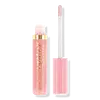What's inside
What's inside
 Key Ingredients
Key Ingredients

 Benefits
Benefits

 Concerns
Concerns

 Ingredients Side-by-side
Ingredients Side-by-side

Petrolatum
EmollientPolyisobutene
Caprylic/Capric Triglyceride
MaskingPentaerythrityl Tetraisostearate
EmollientMethyl Methacrylate Crosspolymer
PEG-8 Beeswax
EmulsifyingSqualane
EmollientSilica
AbrasiveTribehenin
EmollientPhenoxyethanol
PreservativeTocopheryl Acetate
AntioxidantSimmondsia Chinensis Seed Oil
EmollientHelianthus Annuus Seed Oil
EmollientSalvia Hispanica Seed Oil
MoisturisingParfum
MaskingIsohexadecane
EmollientRetinyl Palmitate
Skin ConditioningBHT
AntioxidantEthylene/Propylene/Styrene Copolymer
Butylene/Ethylene/Styrene Copolymer
Sodium Hyaluronate
HumectantXanthan Gum
EmulsifyingTocopherol
AntioxidantTripeptide-1
Skin ConditioningBenzyl Benzoate
AntimicrobialCI 77891
Cosmetic ColorantIron Oxides
Petrolatum, Polyisobutene, Caprylic/Capric Triglyceride, Pentaerythrityl Tetraisostearate, Methyl Methacrylate Crosspolymer, PEG-8 Beeswax, Squalane, Silica, Tribehenin, Phenoxyethanol, Tocopheryl Acetate, Simmondsia Chinensis Seed Oil, Helianthus Annuus Seed Oil, Salvia Hispanica Seed Oil, Parfum, Isohexadecane, Retinyl Palmitate, BHT, Ethylene/Propylene/Styrene Copolymer, Butylene/Ethylene/Styrene Copolymer, Sodium Hyaluronate, Xanthan Gum, Tocopherol, Tripeptide-1, Benzyl Benzoate, CI 77891, Iron Oxides
Polyglyceryl-2 Isostearate/Dimer Dilinoleate Copolymer
EmollientHelianthus Annuus Seed Oil
EmollientCocos Nucifera Oil
MaskingCamellia Japonica Seed Oil
EmollientCaprylic/Capric Triglyceride
MaskingDextrin Myristate
EmulsifyingAloe Barbadensis Leaf Extract
EmollientCannabis Sativa Seed Oil
EmollientCarthamus Tinctorius Seed Oil
MaskingAgave Tequilana Leaf Extract
AstringentMentha Piperita Oil
MaskingTocopheryl Acetate
AntioxidantPentaerythrityl Tetraisostearate
EmollientMica
Cosmetic ColorantParfum
MaskingCitral
PerfumingLimonene
PerfumingLinalool
PerfumingCI 19140
Cosmetic ColorantCI 42090
Cosmetic ColorantPolyglyceryl-2 Isostearate/Dimer Dilinoleate Copolymer, Helianthus Annuus Seed Oil, Cocos Nucifera Oil, Camellia Japonica Seed Oil, Caprylic/Capric Triglyceride, Dextrin Myristate, Aloe Barbadensis Leaf Extract, Cannabis Sativa Seed Oil, Carthamus Tinctorius Seed Oil, Agave Tequilana Leaf Extract, Mentha Piperita Oil, Tocopheryl Acetate, Pentaerythrityl Tetraisostearate, Mica, Parfum, Citral, Limonene, Linalool, CI 19140, CI 42090
 Reviews
Reviews

Alternatives
Ingredients Explained
These ingredients are found in both products.
Ingredients higher up in an ingredient list are typically present in a larger amount.
This ingredient is an emollient, solvent, and texture enhancer. It is considered a skin-softener by helping the skin prevent moisture loss.
It helps thicken a product's formula and makes it easier to spread by dissolving clumping compounds.
Caprylic Triglyceride is made by combining glycerin with coconut oil, forming a clear liquid.
While there is an assumption Caprylic Triglyceride can clog pores due to it being derived from coconut oil, there is no research supporting this.
Learn more about Caprylic/Capric TriglycerideHelianthus Annuus Seed Oil is the oil derived from the seeds of a Sunflower. Sunflower seed oil is non-fragrant. It is an emollient, meaning it helps to soften the skin.
Sunflower seed oil contains many fatty acids. The fatty acids found in sunflower seeds include (from highest amount to least): linoleic acid, myristic acid, palmitic acid, stearic acid, arachidic acid, oleic acid, and linolenic acid.
These fatty acids help the skin create ceramides. Ceramides play a role in repairing the skin barrier.
Helianthus Annuus Seed Oil helps moisturize the skin. This in turn helps the skin look more rejuvenated and smoother.
Sunflowers are rich in vitamin E.
Historians believe Indigenous cultures of North America domesticated sunflowers before corn. Thus they relied on sunflower oil for a variety of uses. One such use is moisturizing skin and hair.
Sunflower seed oil may not be fungal acne safe. We recommend speaking with a professional if you have any concerns.
Learn more about Helianthus Annuus Seed OilParfum is a catch-all term for an ingredient or more that is used to give a scent to products.
Also called "fragrance", this ingredient can be a blend of hundreds of chemicals or plant oils. This means every product with "fragrance" or "parfum" in the ingredients list is a different mixture.
For instance, Habanolide is a proprietary trade name for a specific aroma chemical. When used as a fragrance ingredient in cosmetics, most aroma chemicals fall under the broad labeling category of “FRAGRANCE” or “PARFUM” according to EU and US regulations.
The term 'parfum' or 'fragrance' is not regulated in many countries. In many cases, it is up to the brand to define this term.
For instance, many brands choose to label themselves as "fragrance-free" because they are not using synthetic fragrances. However, their products may still contain ingredients such as essential oils that are considered a fragrance by INCI standards.
One example is Calendula flower extract. Calendula is an essential oil that still imparts a scent or 'fragrance'.
Depending on the blend, the ingredients in the mixture can cause allergies and sensitivities on the skin. Some ingredients that are known EU allergens include linalool and citronellol.
Parfum can also be used to mask or cover an unpleasant scent.
The bottom line is: not all fragrances/parfum/ingredients are created equally. If you are worried about fragrances, we recommend taking a closer look at an ingredient. And of course, we always recommend speaking with a professional.
Learn more about ParfumPentaerythrityl Tetraisostearate is derived from isostearic acid. It is an emollient and emulsifier.
The highest concentration of this ingredient is found in lipsticks.
This ingredient is minimally water soluble and may not be Malassezia folliculitis, or fungal-acne safe.
Learn more about Pentaerythrityl TetraisostearateTocopheryl Acetate is AKA Vitamin E. It is an antioxidant and protects your skin from free radicals. Free radicals damage the skin by breaking down collagen.
One study found using Tocopheryl Acetate with Vitamin C decreased the number of sunburned cells.
Tocopheryl Acetate is commonly found in both skincare and dietary supplements.
Learn more about Tocopheryl Acetate